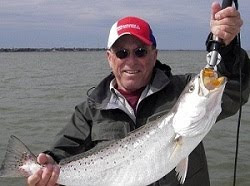How many times have you said, “Man, I wish they would show some courtesy when pulling out of or into my favorite fishing spot”?
It’s an event that takes place too often on Galveston Bay, and for that matter, every other body of water. We are all trying to enjoy the outdoors. I am not without fault. I have made mistakes, rarely on purpose, but nonetheless; I have caused problems in our sport. Remember the old adage, “Been there, done that”.
Respect the other fellow on the water. He deserves a space in which to fish without interference. Our obvious selfishness frequently overrides good judgement. We all have the right to fish public waters. Just try to be courteous and set up your drift or wade fishing patterns without interfering with the other fishermen already in position.
Following this rule for the most part will keep you out of trouble most of the time.
The next rule of thumb is to move slowly and quietly either leaving or entering an area already being fished by other anglers. So many times, fishermen blast into an area criss-crossing patterns already set up by other fishermen. When leaving the area, drift out of the other’s way if you can.
Maybe use your electric trolling motor. Realizing this may take a little longer, in the long run your courtesy will be appreciated by other fishermen who may reciprocate next time for you. If you intend on another drift pattern in the same area do not power up and go around. The wake you just made will definitely interfere with other anglers’ ability to catch fish and will hamper your next drift.
Give wade fishermen a wide berth as you run the shoreline of Galveston Bay. Pushing a two-foot wake onto a chest deep fisherman is a dangerous insult and one that is repeated every weekend.
Wade fishermen are visible from a great distance. Give them as much bay as you would want if you were in their position. If you must pass closely – Because of a channel or shallow water, at least slow down. They will appreciate the gesture.
Interfering on areas that are already taken can cause awkward apologies; none of which are appreciated and the damage has already been done.
Check the wind and current and note the angle at which other boats are riding at anchor. Ease out and around up current and slip the anchor. Use a long line and drift into position.
Courtesy should exist among waders, too. Usually, a line is formed in an angle with the wind at your back, if you decide to join them, slip in at either end – not in the middle where others are already having a well-deserved rodbowing bonanza. Remember that they were there first. Take up the rear or find another spot to fish.
Some waders move faster than others, A guy soaking live shrimp is casting and retrieving at a deliberate pace, while a person throwing a spoon is trying to cover as much water as possible. If you intent on going around, announce your intentions and wade in closer to the shoreline.
Another good suggestion is that strangers catching fish do not need help as sometimes this writer has witnessed first hand. The temptation to crowd a bent rod is overwhelming, but those guys, not you, found the fish. Remember that the angler deserves a fish without interference. These guys have earned their success.
Fish move. Hold your position near them and you may get lucky as the school of trout or reds passes in your casting range. Sometimes, successful fishermen may appreciate your courtesy and wave you in. It does happen.
Some savvy anglers know that several rods can hold a hot school better than one rod. But, again, it is their decision.
Following these suggestions will keep most weekend anglers out of trouble. And, the water around us becomes a lot less crowded.
As always, have fun outdoors and good luck fishing.
See y’all on Galveston Bay.
Capt. Paul Marcaccio
